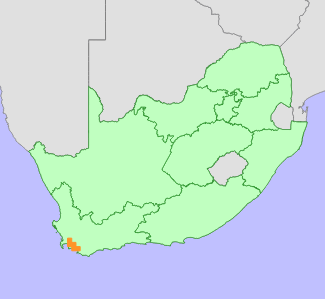|
Scientific Name | Disa brachyceras Lindl. |
Higher Classification | Monocotyledons |
Family | ORCHIDACEAE |
Synonyms | Disa tenella (L.f.) Sw. var. brachyceras (Lindl.) Schltr. |
National Status |
Status and Criteria | Critically Endangered B1ab(iii)+2ab(iii); C2a(ii) |
Assessment Date | 2012/09/13 |
Assessor(s) | W.R. Liltved, B. Bytebier, N.A. Helme & D. Raimondo |
Justification | Historically occurring between the Cape Peninsula and Hermanus (historic EOO 4342 km²) and previously recorded from nine locations, all but one have gone extinct due to urban and agricultural expansion. Only one location remains (EOO <1 km²) and there are fewer than 100 mature individuals. The population continues to decline as this species is dependent on fire and the remnant fragment on which it occurs is surrounded by intensive crop cultivation and is not being burnt. It is therefore listed as Critically Endangered under criteria B and C. |
Distribution |
Endemism | South African endemic |
Provincial distribution | Western Cape |
Range | This species historically occurred from Stellenbosch to Stanford, but is currently known only from Shaw's Mountain. |
Habitat and Ecology |
Major system | Terrestrial |
Major habitats | Swartland Granite Renosterveld, Overberg Sandstone Fynbos, Elgin Shale Fynbos, Cape Winelands Shale Fynbos, Elim Ferricrete Fynbos |
Description | Plants grow in fynbos and renosterveld, on mountain foothills, gravely plains and alluvial flats, sandy and clay soils. |
Threats |
| This species has declined in the past due to destruction of Cape lowland habitats by urban expansion and cultivation. Remaining habitat fragments do not burn often, and as this species is dependent on fire for flowering, this results in ongoing decline. The only known remaining subpopulation occurs on a small fragment surrounded by crop fields. |
Population |
Annual monitoring indicates that ± 25 flowering individuals survive, however, not all individuals are likely to flower every year, particularly in the absence of fire. The population is estimated to be less than 100 mature individuals.
|
Population trend | Decreasing |
Assessment History |
Taxon assessed |
Status and Criteria |
Citation/Red List version | | Disa brachyceras Lindl. | EN B1ab(i,iii,iv) | 2012.1 | | Disa brachyceras Lindl. | EN B1ab(i,iii,iv) | Raimondo et al. (2009) | | Disa brachyceras Lindl. | Lower Risk - Least Concern | Victor (2002) | | Disa brachyceras Lindl. | Rare | Hilton-Taylor (1996) | | Disa brachyceras Lindl. | Uncertain | Hall et al. (1980) | |
Bibliography |
Goldblatt, P. and Manning, J.C. 2000. Cape Plants: A conspectus of the Cape Flora of South Africa. Strelitzia 9. National Botanical Institute, Cape Town.
Hall, A.V., De Winter, M., De Winter, B. and Van Oosterhout, S.A.M. 1980. Threatened plants of southern Africa. South African National Scienctific Programmes Report 45. CSIR, Pretoria.
Hilton-Taylor, C. 1996. Red data list of southern African plants. Strelitzia 4. South African National Botanical Institute, Pretoria.
Liltved, W.R. and Johnson, S.D. Unpublished. The Cape Orchids - Wild orchids of the Cape Floral Kingdom.
Linder, H.P. 1981. Taxonomic studies in the Disinae. III. A revision of Disa Berg. excluding sect. Micranthae Lindl. Contributions from the Bolus Herbarium 9:1-370.
Linder, H.P. and Kurzweil, H. 1999. Orchids of southern Africa. A.A. Balkema, Rotterdam.
Raimondo, D., von Staden, L., Foden, W., Victor, J.E., Helme, N.A., Turner, R.C., Kamundi, D.A. and Manyama, P.A. 2009. Red List of South African Plants. Strelitzia 25. South African National Biodiversity Institute, Pretoria.
Victor, J.E. 2002. South Africa. In: J.S. Golding (ed), Southern African plant Red Data Lists. Southern African Botanical Diversity Network Report 14 (pp. 93-120), SABONET, Pretoria.
|
Citation |
| Liltved, W.R., Bytebier, B., Helme, N.A. & Raimondo, D. 2012. Disa brachyceras Lindl. National Assessment: Red List of South African Plants version 2024.1. Accessed on 2025/10/30 |
 Comment on this assessment
Comment on this assessment


